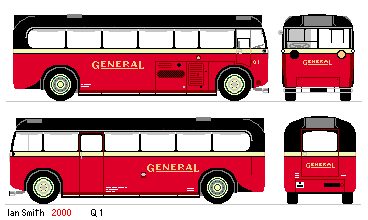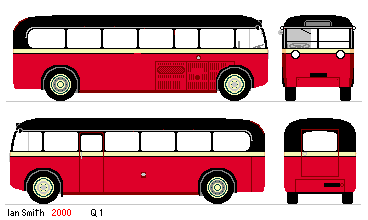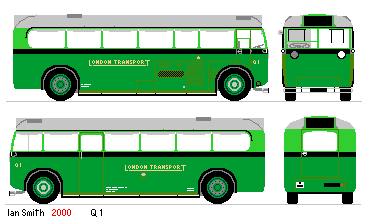
The LONDON TRANSPORT AEC Q classThis page created 7th January 2001, using Notepad, by Ian Smith.The 1Q1: the prototype QRackham persuaded the London General Omnibus Co to share in the prototype Q single-decker (Birmingham took the double-decker), no doubt conscious of the need to have LT's stamp of approval in order to get the unusual design off the ground commercially. The body was designed by the LGOC at Chiswick, but conformed very closely with the AEC design and model.
Chassis: AEC Q, 18ft 6in wheelbase, AEC A167 petrol engine
Mechanically it was revolutionary too - or counter-revolutionary! The engine rotated anti-clockwise, and was fitted with the manifolds on the offside, for easy access. It was tilted too, to fit under a bench seat in the bus. A special starter, oil pump and worm were required to deal with the queer engine. The offside mounted engine drove back through a gearbox that was also mounted outside the frame, to a differential just inside the splayed rear frames. Large single tyres on the rear allowed the drive line to be almost straight. The weight distribution was so uneven that each wheel had different springs. Livery was red with a cream waist-band, and an unusual black roof and rear dome.
Trials and modificationsThe prototype emerged at Chiswick in the spring of 1932. After trials it went to the Public Carriage Office of the Metropolitan Police (where my grand-father was an inspector). Probably as a result of that visit, some changes were made:
Into serviceProbably for publicity purposes, and for its high public profile, Q1 was placed into service on route 11, through the hearts of the City and Westminster, in September 1932. It wasn't really suited to the duty, with its narrow single doorway, and it did lose time compared with the normal LTs on the route, with their wide open platforms.
The following month, once the fuss had died down
it was moved from Riverside (R) to Nunhead (AH)
where the quiet 621 suited it much better.
The LGOC bought the AEC share of the bus in January 1933, and London Transport took it over in July.
It pottered around on Reigate local services during the remaining pre-war years.
Alterations at overhaul saw the headlights lowered to a more sensible position, and a foglight fitted.
It also acquired a 4Q4 style front end at some time,
although with a proud-standing destination box to suit its lower roof profile.
It was delicensed in September 1942, and stored at Tunbridge Wells and Guildford before its sale in January 1946.
It then continued in existence for a while as a hen-house.
|
 The prototype was certainly very different from anything seen in Britain before.
The first obvious point of departure was the front,
with its lack of a radiator and full-width glazing.
This when LT was still struggling to gain acceptance for drivers' windscreens
on its half-cabs. Then there was its overall sleekness and curved panelling.
Chiswick gave it a heavy waist-moulding that detracted somewhat from the smooth lines
of the AEC design model, but it was still a blazingly modern design.
Chiswick also raised the position of the huge headlamps
to the waist-band. Such high lamps must have been a real headache to cars in front.
Initially it had small discrete destination indicators on front and back.
The prototype was certainly very different from anything seen in Britain before.
The first obvious point of departure was the front,
with its lack of a radiator and full-width glazing.
This when LT was still struggling to gain acceptance for drivers' windscreens
on its half-cabs. Then there was its overall sleekness and curved panelling.
Chiswick gave it a heavy waist-moulding that detracted somewhat from the smooth lines
of the AEC design model, but it was still a blazingly modern design.
Chiswick also raised the position of the huge headlamps
to the waist-band. Such high lamps must have been a real headache to cars in front.
Initially it had small discrete destination indicators on front and back.
 London Transport loaned it to the Country Area in December 1933 for Green Line trials,
and then allocated it to Reigate for bus duties from February 1934.
It was repainted in green with a black waist-band and silver roof.
London Transport loaned it to the Country Area in December 1933 for Green Line trials,
and then allocated it to Reigate for bus duties from February 1934.
It was repainted in green with a black waist-band and silver roof.
 bus histories
bus histories Bus Stop
Bus Stop Q index.
Q index. 1Q1
1Q1